Họ Tên: AAA, nhân viên Công ty BBB.
Kính gửi: ông CCC, Giám đốc BBB.
Tôi rất lấy làm tiếc vì sẽ không còn làm việc tại BBB trong thời gian sắp tới. Tôi rất hài lòng và lấy làm một vinh dự lớn được làm việc tại đây trong thời gian qua. Trong quá trình làm việc tại đây, công ty đã cho tôi có được may mắn làm việc với những đồng nghiệp chân thành cùng với một môi trường làm việc tốt. Tôi chân thành cầu chúc cho ông và công ty chúng ta sẽ đạt được những thành công như mong muốn.
Tôi quyết định ngưng công việc để tiếp tục công việc học tập cá nhân cũng như giải quyết một số công việc trong gia đình tôi thời gian tới.
Tôi sẽ rất hân hạnh được giúp công ty trong việc giúp đỡ, hướng dẫn và hợp tác với người thay vào vị trí của tôi hiện nay nếu công ty có nhu cầu, cũng như sẽ tiếp tục đóng góp cho sự phát triển của công ty trong thời gian sau này với khả năng của mình ở vai trò khác hoặc hợp tác với công ty, nếu có thể.
Tôi xin chân thành cảm ơn công ty đã tin tưởng tôi trong suốt thời gian vừa qua.
Một lần nữa, rất mong BBB của chúng ta ngày càng thịnh vượng.
Thứ 6, ngày 13 tháng ZZZ năm XXX.
Chân thành,
Ký tên.
Họ tên.
copyright vtalinh
Tim kiếm với Google

Tìm kiếm Tùy Chỉnh
Kết Quả tìm kiếm

Thứ Tư, 26 tháng 9, 2007
Thứ Hai, 24 tháng 9, 2007
Free SMS ( Nhắn tin miễn phí )
Đây là dịch vụ gửi tin nhắn sms free. đã test, hiện đang xài thấy ngon quá share cho mọi người!
thề là kô bị trừ tài khoản nào đâu
Đầu tiên mọi người vào http://www.romsms.com/?refid=WBA1qogr đăng ký.
- Nhớ chọn language English bằng cách click vào cờ Anh bên tay phải góc trên nhé.
- Đăng kí tên, email, country (chọn Việt Nam nếu bạn ở VN ),..
- Đăng ký sdt của mình theo dạng : 849xxxxxxxx , chú ý là ko phải +849xxxxx VD : số điện thoại tớ là 0983xxxx thì đăng kí sẽ là 84983xxxx
- Sau khi đăng ký pass sẽ đc gửi về máy mình
- Login = pass đó rồi vào Change my details đổi pass cho dễ nhớ.
Lưu ý :
* Khi gửi tin nhớ chọn sender là sdt của mình, mặc định của họ là ROMSMS. Ng` nhận sẽ nhận dc từ chính sdt của mình, chỉ thêm 1 dòng nhỏ là romSMS.com
* Số điện thoại đăng nhập - số điện thoại gửi đi, đều phải có dạng 849xxxx. (84 là mã Việt Nam, 9xxx là số đt bỏ số 0 ở đầu) .
* Khi khởi tạo sẽ đc 5 tin miễn phí, mỗi ngày + 2 tin. Invite 1 người bạn đăng ký thành công qua YM hay mail dc + thêm 5 tin nữa.
thề là kô bị trừ tài khoản nào đâu
Đầu tiên mọi người vào http://www.romsms.com/?refid=WBA1qogr đăng ký.
- Nhớ chọn language English bằng cách click vào cờ Anh bên tay phải góc trên nhé.
- Đăng kí tên, email, country (chọn Việt Nam nếu bạn ở VN ),..
- Đăng ký sdt của mình theo dạng : 849xxxxxxxx , chú ý là ko phải +849xxxxx VD : số điện thoại tớ là 0983xxxx thì đăng kí sẽ là 84983xxxx
- Sau khi đăng ký pass sẽ đc gửi về máy mình
- Login = pass đó rồi vào Change my details đổi pass cho dễ nhớ.
Lưu ý :
* Khi gửi tin nhớ chọn sender là sdt của mình, mặc định của họ là ROMSMS. Ng` nhận sẽ nhận dc từ chính sdt của mình, chỉ thêm 1 dòng nhỏ là romSMS.com
* Số điện thoại đăng nhập - số điện thoại gửi đi, đều phải có dạng 849xxxx. (84 là mã Việt Nam, 9xxx là số đt bỏ số 0 ở đầu) .
* Khi khởi tạo sẽ đc 5 tin miễn phí, mỗi ngày + 2 tin. Invite 1 người bạn đăng ký thành công qua YM hay mail dc + thêm 5 tin nữa.
Thứ Năm, 13 tháng 9, 2007
Nghệ Thuật Xếp Giấy NHật Bản Origami
 Origami cũng như nhiều từ tiếng Nhật như sake, shushi, kimono ... đã được quốc tế hóa để khi nhắc đến ai cũng hiểu đó là một đặc trưng của văn hóa Nhật, không lẫn vào đâu được. Và dù bây giờ Origami đã phát triển vượt biên giới, thành nhiều lĩnh vực khác nhau ,mang lại niềm say mê cho biết bao nhiêu người trên tòan thế giới, nhưng tất cả vẫn trân trọng gọi nghệ thuật xếp giấy bằng cái tên Origami như một sự tưởng nhớ đến cái nôi cho một sự hình thành và phát triển một môn nghệ thuật độc lập.
Origami cũng như nhiều từ tiếng Nhật như sake, shushi, kimono ... đã được quốc tế hóa để khi nhắc đến ai cũng hiểu đó là một đặc trưng của văn hóa Nhật, không lẫn vào đâu được. Và dù bây giờ Origami đã phát triển vượt biên giới, thành nhiều lĩnh vực khác nhau ,mang lại niềm say mê cho biết bao nhiêu người trên tòan thế giới, nhưng tất cả vẫn trân trọng gọi nghệ thuật xếp giấy bằng cái tên Origami như một sự tưởng nhớ đến cái nôi cho một sự hình thành và phát triển một môn nghệ thuật độc lập.Mouse Origami ( Xếp hình Con Chuột )
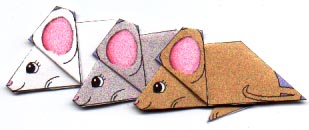
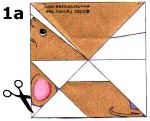 Cut out image along outer solid lines
Cut out image along outer solid lines
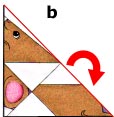 Fold back along diagonal line A.
Fold back along diagonal line A.
Unfold.
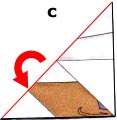 Fold back along diagonal line B.
Fold back along diagonal line B.
Unfold
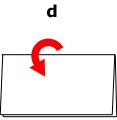 Fold forward along line C.
Fold forward along line C.
Unfold.
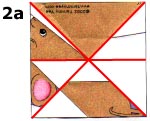 Your origami should be creased along the red lines as shown.
Your origami should be creased along the red lines as shown.
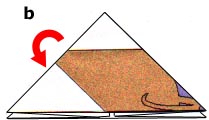 Carefully fold along creases into a "tent" form as shown.
Carefully fold along creases into a "tent" form as shown.

 Cut out image along outer solid lines
Cut out image along outer solid lines Fold back along diagonal line A.
Fold back along diagonal line A.Unfold.
 Fold back along diagonal line B.
Fold back along diagonal line B.Unfold
 Fold forward along line C.
Fold forward along line C.Unfold.
$$$$$$$$$$$$$$$$$$$$$$$$$$$$$
 Your origami should be creased along the red lines as shown.
Your origami should be creased along the red lines as shown. Carefully fold along creases into a "tent" form as shown.
Carefully fold along creases into a "tent" form as shown.Fold ear up along line D
&&&&&&&&&&&&&&&&&&&&&&&&
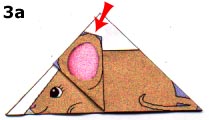 Fold tip of ear back along line E
Fold tip of ear back along line E
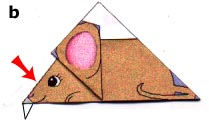 Form head by folding back along diagonal line F.
Form head by folding back along diagonal line F.
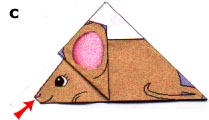 Fold back tip of nose as shown.
Fold back tip of nose as shown.
#########################
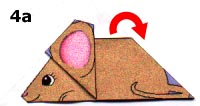 Fold back along line G
Fold back along line G
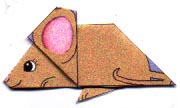 Fold hind leg forward along line H.
Fold hind leg forward along line H.
Còn các Hình khác thì bạn hãy nhấp vào các link bên để tham khảo nha
Nature
Bunny
Butterfly
Cat
Dolphin
Fish
Frog
Hawaiian Tree Snail (Pupu Kani Oe)
Honu (Sea Turtle)
Iris
'Opihi
Poi Puppy
Pueo (owl)
Whale
 Fold tip of ear back along line E
Fold tip of ear back along line E Form head by folding back along diagonal line F.
Form head by folding back along diagonal line F. Fold back tip of nose as shown.
Fold back tip of nose as shown.#########################
 Fold back along line G
Fold back along line G Fold hind leg forward along line H.
Fold hind leg forward along line H.Còn các Hình khác thì bạn hãy nhấp vào các link bên để tham khảo nha
Nature
Bunny
Butterfly
Cat
Dolphin
Fish
Frog
Hawaiian Tree Snail (Pupu Kani Oe)
Honu (Sea Turtle)
Iris
'Opihi
Poi Puppy
Pueo (owl)
Whale
Holidays
Angel
Christmas Tree
Easter Chick Box
Easter Chick
Halloween Pumpkin Box
Santa Claus
St. Patrick's Day Shamrock Box
Pilgrim's Hat
Turkey
Valentine Card, Pop-up
Angel
Christmas Tree
Easter Chick Box
Easter Chick
Halloween Pumpkin Box
Santa Claus
St. Patrick's Day Shamrock Box
Pilgrim's Hat
Turkey
Valentine Card, Pop-up
Multicultural
Aloha Shirt
Dragon Fortune Teller
Dragon Puppet
Emperor for Girls' Day
Empress for Girls' Day
Koi-nobori for Boy's Day
Musubi
Aloha Shirt
Dragon Fortune Teller
Dragon Puppet
Emperor for Girls' Day
Empress for Girls' Day
Koi-nobori for Boy's Day
Musubi
Thứ Tư, 5 tháng 9, 2007
Trò chuyện đêm khuya - Ngày 31/8/2007
Trò chuyện đêm khuya : Chương trình tư vấn tâm lý trực tiếp trên sóng FM 99.9 Đài tiếng nói nhân dân thành phồ Hồ Chí Minh( Deep night chin-wag: direct psychological advisory program on people speech 99.9 Calix FM wave TP.Ho Chi Minh )
Hãy gọi (08)9101101 - Tell us (08)9101101
Vấn đề 1: Nhà vợ không cho con em mang họ em
Hãy gọi (08)9101101 - Tell us (08)9101101
Vấn đề 1: Nhà vợ không cho con em mang họ em
Thứ Hai, 3 tháng 9, 2007
A Short Course on Automobile Engines by Charles Ofria
Internal combustion gasoline engines run on a mixture of gasoline and air. The ideal mixture is 14.7 parts of air to one part of gasoline (by weight.) Since gas weighs much more than air, we are talking about a whole lot of air and a tiny bit of gas. One part of gas that is completely vaporized into 14.7 parts of air can produce tremendous power when ignited inside an engine.
Let's see how the modern engine uses that energy to make the wheels turn.
Air enters the engine through the air cleaner and proceeds to the throttle plate. You control the amount of air that passes through the throttle plate and into the engine with the gas pedal. It is then distributed through a series of passages called the intake manifold, to each cylinder. At some point after the air cleaner, depending on the engine, fuel is added to the air-stream by either a fuel injection system or, in older vehicles, by the carburetor.
Once the fuel is vaporized into the air stream, the mixture is drawn into each cylinder as that cylinder begins its intake stroke. When the piston reaches the bottom of the cylinder, the intake valve closes and the piston begins moving up in the cylinder compressing the charge. When the piston reaches the top, the spark plug ignites the fuel-air mixture causing a powerful expansion of the gas, which pushes the piston back down with great force against the crankshaft, just like a bicycle rider pushing against the pedals to make the bike go.
Let's take a closer look at this process.
Engine Types
The majority of engines in motor vehicles today are four-stroke, spark-ignition internal combustion engines. The exceptions like the diesel and rotary engines will not be covered in this article.
There are several engine types which are identified by the number of cylinders and the way the cylinders are laid out. Motor vehicles will have from 3 to 12 cylinders which are arranged in the engine block in several configurations. The most popular of them are shown on the left. In-line engines have their cylinders arranged in a row. 3, 4, 5 and 6 cylinder engines commonly use this arrangement. The "V" arrangement uses two banks of cylinders side-by-side and is commonly used in V-6, V-8, V-10 and V-12 configurations. Flat engines use two opposing banks of cylinders and are less common than the other two designs. They are used in engines from Subaru and Porsche in 4 and 6 cylinder arrangements as well as in the old VW beetles with 4 cylinders. Flat engines are also used in some Ferraris with 12 cylinders
Most engine blocks are made of cast iron or cast aluminum..
Each cylinder contains a piston that travels up and down inside the cylinder bore. All the pistons in the engine are connected through individual connecting rods to a common crankshaft.
The crankshaft is located below the cylinders on an in-line engine, at the base of the V on a V-type engine and between the cylinder banks on a flat engine. As the pistons move up and down, they turn the crankshaft just like your legs pump up and down to turn the crank that is connected to the pedals of a bicycle.
A cylinder head is bolted to the top of each bank of cylinders to seal the individual cylinders and contain the combustion process that takes place inside the cylinder. Most cylinder heads are made of cast aluminum or cast iron. The cylinder head contains at least one intake valve and one exhaust valve for each cylinder. This allows the air-fuel mixture to enter the cylinder and the burned exhaust gas to exit the cylinder. Engines have at least two valves per cylinder, one intake valve and one exhaust valve. Many newer engines are using multiple intake and exhaust valves per cylinder for increased engine power and efficiency. These engines are sometimes named for the number of valves that they have such as "24 Valve V6" which indicates a V-6 engine with four valves per cylinder. Modern engine designs can use anywhere from 2 to 5 valves per cylinder.
The valves are opened and closed by means of a camshaft. A camshaft is a rotating shaft that has individual lobes for each valve. The lobe is a "bump" on one side of the shaft that pushes against a valve lifter moving it up and down. When the lobe pushes against the lifter, the lifter in turn pushes the valve open. When the lobe rotates away from the lifter, the valve is closed by a spring that is attached to the valve. A common configuration is to have one camshaft located in the engine block with the lifters connecting to the valves through a series of linkages. The camshaft must be synchronized with the crankshaft so that the camshaft makes one revolution for every two revolutions of the crankshaft. In most engines, this is done by a "Timing Chain" (similar to a bicycle chain) that connects the camshaft with the crankshaft. Newer engines have the camshaft located in the cylinder head directly over the valves. This design is more efficient but it is more costly to manufacture and requires multiple camshafts on Flat and V-type engines. It also requires much longer timing chains or timing belts which are prone to wear. Some engines have two camshafts on each head, one for the intake valves and one for the exhaust valves. These engines are called Double Overhead Camshaft (D.O.H.C.) Engines while the other type is called Single Overhead Camshaft (S.O.H.C.) Engines. Engines with the camshaft in the block are called Overhead Valve (O.H.V) Engines.
Now when you see "DOHC 24 Valve V6", you'll know what it means.
How an Engine Works
Since the same process occurs in each cylinder, we will take a look at one cylinder to see how the four stroke process works.
The four strokes are Intake, Compression, Power and Exhaust. The piston travels down on the Intake stroke, up on the Compression stroke, down on the Power stroke and up on the Exhaust stroke.
Intake
As the piston starts down on the Intake stroke, the intake valve opens and the fuel-air mixture is drawn into the cylinder (similar to drawing back the plunger on a hypodermic needle to allow fluid to be drawn into the chamber.)
When the piston reaches the bottom of the intake stroke, the intake valve closes, trapping the air-fuel mixture in the cylinder.
Compression
The piston moves up and compresses the trapped air fuel mixture that was brought in by the intake stroke. The amount that the mixture is compressed is determined by the compression ratio of the engine. The compression ratio on the average engine is in the range of 8:1 to 10:1.
This means that when the piston reaches the top of the cylinder, the air-fuel mixture is squeezed to about one tenth of its original volume.
Power
The spark plug fires, igniting the compressed air-fuel mixture which produces a powerful expansion of the vapor. The combustion process pushes the piston down the cylinder with great force turning the crankshaft to provide the power to propel the vehicle. Each piston fires at a different time, determined by the engine firing order. By the time the crankshaft completes two revolutions, each cylinder in the engine will have gone through one power stroke.
Exhaust
With the piston at the bottom of the cylinder, the exhaust valve opens to allow the burned exhaust gas to be expelled to the exhaust system. Since the cylinder contains so much pressure, when the valve opens, the gas is expelled with a violent force (that is why a vehicle without a muffler sounds so loud.) The piston travels up to the top of the cylinder pushing all the exhaust out before closing the exhaust valve in preparation for starting the four stroke process over again.
Oiling System
Oil is the life-blood of the engine. An engine running without oil will last about as long as a human without blood. Oil is pumped under pressure to all the moving parts of the engine by an oil pump. The oil pump is mounted at the bottom of the engine in the oil pan and is connected by a gear to either the crankshaft or the camshaft. This way, when the engine is turning, the oil pump is pumping. There is an oil pressure sensor near the oil pump that monitors pressure and sends this information to a warning light or a gauge on the dashboard. When you turn the ignition key on, but before you start the car, the oil light should light, indicating that there is no oil pressure yet, but also letting you know that the warning system is working. As soon as you start cranking the engine to start it, the light should go out indicating that there is oil pressure.
Engine Cooling
Internal combustion engines must maintain a stable operating temperature, not too hot and not too cold. With the massive amounts of heat that is generated from the combustion process, if the engine did not have a method for cooling itself, it would quickly self-destruct. Major engine parts can warp causing oil and water leaks and the oil will boil and become useless.
While some engines are air-cooled, the vast majority of engines are liquid cooled. The water pump circulates coolant throughout the engine, hitting the hot areas around the cylinders and heads and then sends the hot coolant to the radiator to be cooled off. For more information on the cooling system, click here.
Engine Balance
Flywheel A 4 cylinder engine produces a power stroke every half crankshaft revolution, an 8 cylinder, every quarter revolution. This means that a V8 will be smother running than a 4. To keep the combustion pulses from generating a vibration, a flywheel is attached to the back of the crankshaft. The flywheel is a disk that is about 12 to 15 inches in diameter. On a standard transmission car, the flywheel is a heavy iron disk that doubles as part of the clutch system. On automatic equipped vehicles, the flywheel is a stamped steel plate that mounts the heavy torque converter. The flywheel uses inertia to smooth out the normal engine pulses.
Balance Shaft Some engines have an inherent rocking motion that produces an annoying vibration while running. To combat this, engineers employ one or more balance shafts. A balance shaft is a heavy shaft that runs through the engine parallel to the crankshaft. This shaft has large weights that, while spinning, offset the rocking motion of the engine by creating an opposite rocking motion of their own.
Let's see how the modern engine uses that energy to make the wheels turn.
Air enters the engine through the air cleaner and proceeds to the throttle plate. You control the amount of air that passes through the throttle plate and into the engine with the gas pedal. It is then distributed through a series of passages called the intake manifold, to each cylinder. At some point after the air cleaner, depending on the engine, fuel is added to the air-stream by either a fuel injection system or, in older vehicles, by the carburetor.
Once the fuel is vaporized into the air stream, the mixture is drawn into each cylinder as that cylinder begins its intake stroke. When the piston reaches the bottom of the cylinder, the intake valve closes and the piston begins moving up in the cylinder compressing the charge. When the piston reaches the top, the spark plug ignites the fuel-air mixture causing a powerful expansion of the gas, which pushes the piston back down with great force against the crankshaft, just like a bicycle rider pushing against the pedals to make the bike go.
Let's take a closer look at this process.
Engine Types
The majority of engines in motor vehicles today are four-stroke, spark-ignition internal combustion engines. The exceptions like the diesel and rotary engines will not be covered in this article.
There are several engine types which are identified by the number of cylinders and the way the cylinders are laid out. Motor vehicles will have from 3 to 12 cylinders which are arranged in the engine block in several configurations. The most popular of them are shown on the left. In-line engines have their cylinders arranged in a row. 3, 4, 5 and 6 cylinder engines commonly use this arrangement. The "V" arrangement uses two banks of cylinders side-by-side and is commonly used in V-6, V-8, V-10 and V-12 configurations. Flat engines use two opposing banks of cylinders and are less common than the other two designs. They are used in engines from Subaru and Porsche in 4 and 6 cylinder arrangements as well as in the old VW beetles with 4 cylinders. Flat engines are also used in some Ferraris with 12 cylinders
Most engine blocks are made of cast iron or cast aluminum..
Each cylinder contains a piston that travels up and down inside the cylinder bore. All the pistons in the engine are connected through individual connecting rods to a common crankshaft.
The crankshaft is located below the cylinders on an in-line engine, at the base of the V on a V-type engine and between the cylinder banks on a flat engine. As the pistons move up and down, they turn the crankshaft just like your legs pump up and down to turn the crank that is connected to the pedals of a bicycle.
A cylinder head is bolted to the top of each bank of cylinders to seal the individual cylinders and contain the combustion process that takes place inside the cylinder. Most cylinder heads are made of cast aluminum or cast iron. The cylinder head contains at least one intake valve and one exhaust valve for each cylinder. This allows the air-fuel mixture to enter the cylinder and the burned exhaust gas to exit the cylinder. Engines have at least two valves per cylinder, one intake valve and one exhaust valve. Many newer engines are using multiple intake and exhaust valves per cylinder for increased engine power and efficiency. These engines are sometimes named for the number of valves that they have such as "24 Valve V6" which indicates a V-6 engine with four valves per cylinder. Modern engine designs can use anywhere from 2 to 5 valves per cylinder.
The valves are opened and closed by means of a camshaft. A camshaft is a rotating shaft that has individual lobes for each valve. The lobe is a "bump" on one side of the shaft that pushes against a valve lifter moving it up and down. When the lobe pushes against the lifter, the lifter in turn pushes the valve open. When the lobe rotates away from the lifter, the valve is closed by a spring that is attached to the valve. A common configuration is to have one camshaft located in the engine block with the lifters connecting to the valves through a series of linkages. The camshaft must be synchronized with the crankshaft so that the camshaft makes one revolution for every two revolutions of the crankshaft. In most engines, this is done by a "Timing Chain" (similar to a bicycle chain) that connects the camshaft with the crankshaft. Newer engines have the camshaft located in the cylinder head directly over the valves. This design is more efficient but it is more costly to manufacture and requires multiple camshafts on Flat and V-type engines. It also requires much longer timing chains or timing belts which are prone to wear. Some engines have two camshafts on each head, one for the intake valves and one for the exhaust valves. These engines are called Double Overhead Camshaft (D.O.H.C.) Engines while the other type is called Single Overhead Camshaft (S.O.H.C.) Engines. Engines with the camshaft in the block are called Overhead Valve (O.H.V) Engines.
Now when you see "DOHC 24 Valve V6", you'll know what it means.
How an Engine Works
Since the same process occurs in each cylinder, we will take a look at one cylinder to see how the four stroke process works.
The four strokes are Intake, Compression, Power and Exhaust. The piston travels down on the Intake stroke, up on the Compression stroke, down on the Power stroke and up on the Exhaust stroke.
Intake
As the piston starts down on the Intake stroke, the intake valve opens and the fuel-air mixture is drawn into the cylinder (similar to drawing back the plunger on a hypodermic needle to allow fluid to be drawn into the chamber.)
When the piston reaches the bottom of the intake stroke, the intake valve closes, trapping the air-fuel mixture in the cylinder.
Compression
The piston moves up and compresses the trapped air fuel mixture that was brought in by the intake stroke. The amount that the mixture is compressed is determined by the compression ratio of the engine. The compression ratio on the average engine is in the range of 8:1 to 10:1.
This means that when the piston reaches the top of the cylinder, the air-fuel mixture is squeezed to about one tenth of its original volume.
Power
The spark plug fires, igniting the compressed air-fuel mixture which produces a powerful expansion of the vapor. The combustion process pushes the piston down the cylinder with great force turning the crankshaft to provide the power to propel the vehicle. Each piston fires at a different time, determined by the engine firing order. By the time the crankshaft completes two revolutions, each cylinder in the engine will have gone through one power stroke.
Exhaust
With the piston at the bottom of the cylinder, the exhaust valve opens to allow the burned exhaust gas to be expelled to the exhaust system. Since the cylinder contains so much pressure, when the valve opens, the gas is expelled with a violent force (that is why a vehicle without a muffler sounds so loud.) The piston travels up to the top of the cylinder pushing all the exhaust out before closing the exhaust valve in preparation for starting the four stroke process over again.
Oiling System
Oil is the life-blood of the engine. An engine running without oil will last about as long as a human without blood. Oil is pumped under pressure to all the moving parts of the engine by an oil pump. The oil pump is mounted at the bottom of the engine in the oil pan and is connected by a gear to either the crankshaft or the camshaft. This way, when the engine is turning, the oil pump is pumping. There is an oil pressure sensor near the oil pump that monitors pressure and sends this information to a warning light or a gauge on the dashboard. When you turn the ignition key on, but before you start the car, the oil light should light, indicating that there is no oil pressure yet, but also letting you know that the warning system is working. As soon as you start cranking the engine to start it, the light should go out indicating that there is oil pressure.
Engine Cooling
Internal combustion engines must maintain a stable operating temperature, not too hot and not too cold. With the massive amounts of heat that is generated from the combustion process, if the engine did not have a method for cooling itself, it would quickly self-destruct. Major engine parts can warp causing oil and water leaks and the oil will boil and become useless.
While some engines are air-cooled, the vast majority of engines are liquid cooled. The water pump circulates coolant throughout the engine, hitting the hot areas around the cylinders and heads and then sends the hot coolant to the radiator to be cooled off. For more information on the cooling system, click here.
Engine Balance
Flywheel A 4 cylinder engine produces a power stroke every half crankshaft revolution, an 8 cylinder, every quarter revolution. This means that a V8 will be smother running than a 4. To keep the combustion pulses from generating a vibration, a flywheel is attached to the back of the crankshaft. The flywheel is a disk that is about 12 to 15 inches in diameter. On a standard transmission car, the flywheel is a heavy iron disk that doubles as part of the clutch system. On automatic equipped vehicles, the flywheel is a stamped steel plate that mounts the heavy torque converter. The flywheel uses inertia to smooth out the normal engine pulses.
Balance Shaft Some engines have an inherent rocking motion that produces an annoying vibration while running. To combat this, engineers employ one or more balance shafts. A balance shaft is a heavy shaft that runs through the engine parallel to the crankshaft. This shaft has large weights that, while spinning, offset the rocking motion of the engine by creating an opposite rocking motion of their own.
TRỊNH CÔNG SƠN / LỜI CỦA GIÒNG SÔNG
TRỊNH CÔNG SƠN (1939 - 2001)

Lời của giòng sông_ Guitar solo & Arrangement: Đỗ Đình Phương
Có một giòng sông đã qua đời_ Thu Phương*
Tình xa_ Trần Thu Hà*
Tuổi đá buồn_ Guitar solo Arrgament: Đặng Huy Hoàng
Này em có nhớ_ Thu Phương*
Tình nhớ_ Trần Thu Hà*
Hạ trắng_ Guitar Duo: Huỳnh Hữu Đoan - Nguyễn Xuân Thao; Arrangement: Đặng Huy Hoàng
Rồi như đá ngây ngô_ Thu Phương*
Mưa hồng_ Trần Thu Hà*
Còn tuổi nào cho em_ Guitar solo: Đỗ Đình Phương; Arrangement: Đặng Huy Hoàng & Đỗ Đình Phương
Tình sầu_ Thu Phương*
Xin trả nợ người_ Trần Thu Hà*
Lời của giòng sông_ Guitar solo & Arrangement: Đặng Huy Hoàng

Lời của giòng sông_ Guitar solo & Arrangement: Đỗ Đình Phương
Có một giòng sông đã qua đời_ Thu Phương*
Tình xa_ Trần Thu Hà*
Tuổi đá buồn_ Guitar solo Arrgament: Đặng Huy Hoàng
Này em có nhớ_ Thu Phương*
Tình nhớ_ Trần Thu Hà*
Hạ trắng_ Guitar Duo: Huỳnh Hữu Đoan - Nguyễn Xuân Thao; Arrangement: Đặng Huy Hoàng
Rồi như đá ngây ngô_ Thu Phương*
Mưa hồng_ Trần Thu Hà*
Còn tuổi nào cho em_ Guitar solo: Đỗ Đình Phương; Arrangement: Đặng Huy Hoàng & Đỗ Đình Phương
Tình sầu_ Thu Phương*
Xin trả nợ người_ Trần Thu Hà*
Lời của giòng sông_ Guitar solo & Arrangement: Đặng Huy Hoàng
Đăng ký:
Nhận xét (Atom)
Quảng cáo Google
VOA News: News
Web blog của tôi ( my webblog ) |




